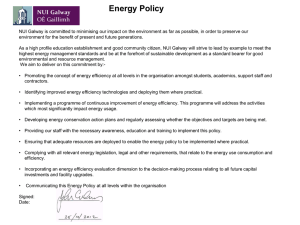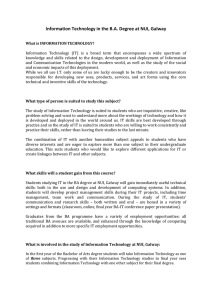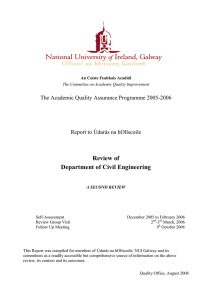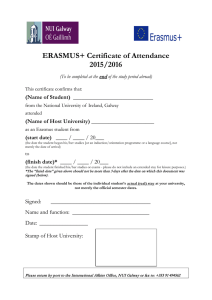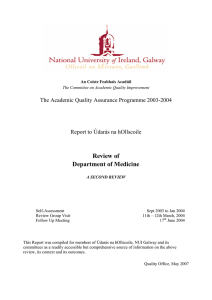Review of Faculty of Medicine and Health Sciences
advertisement
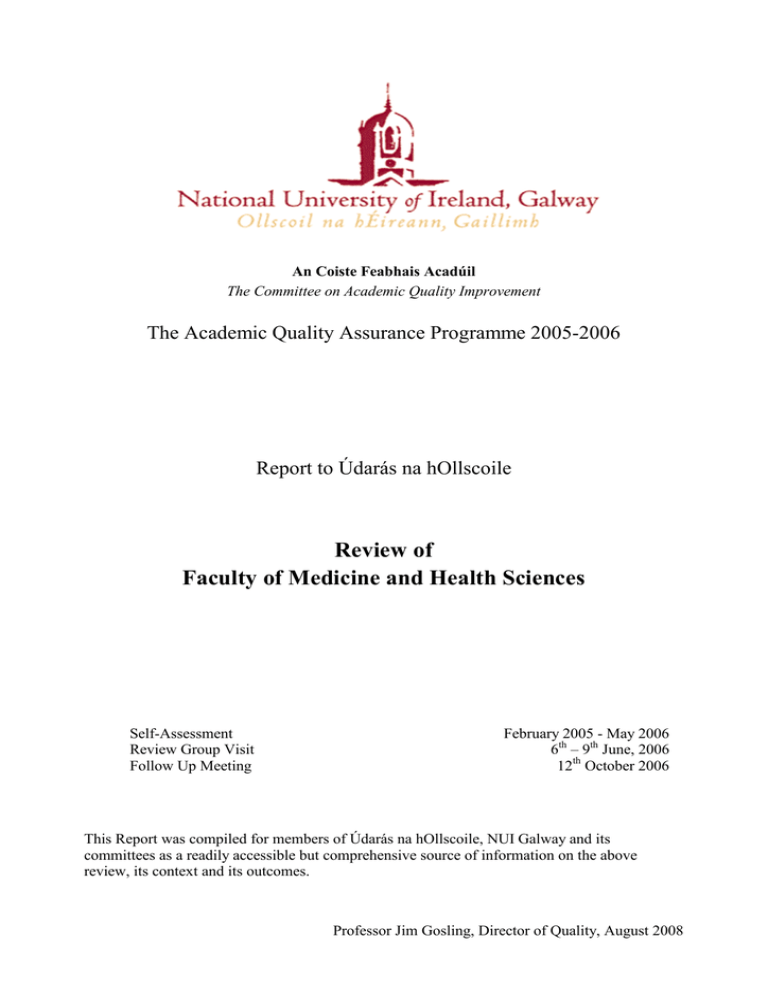
An Coiste Feabhais Acadúil The Committee on Academic Quality Improvement The Academic Quality Assurance Programme 2005-2006 Report to Údarás na hOllscoile Review of Faculty of Medicine and Health Sciences Self-Assessment Review Group Visit Follow Up Meeting February 2005 - May 2006 6th – 9th June, 2006 12th October 2006 This Report was compiled for members of Údarás na hOllscoile, NUI Galway and its committees as a readily accessible but comprehensive source of information on the above review, its context and its outcomes. Professor Jim Gosling, Director of Quality, August 2008 Report to Údarás – Review of Faculty of Medicine and Health Sciences 2005–2006 1. Overview of Faculty 1.1 Missions and Objectives Student mission To educate students of medicine, nursing, occupational therapy, and speech and language therapy in the acquisition of the knowledge, skills and attitudes necessary for a lifetime of continuing patient care, learning, personal development and contribution to society. Society mission To advance knowledge through research and scholarship of international repute. To equip graduates with attributes appropriate to the needs of society, both locally and internationally. Staff mission To promote continuing personal and professional development through the provision of an organisation of academic, research and administrative excellence, and a culture of appreciation, opportunity and reward. Objectives To promote the education of high calibre graduates in Medicine and Health Sciences; To educated health professionals who are sensitive to patient needs, and who provide optimum health care; To promote best teaching and educational practice in the delivery of the curricula at NUI Galway; To facilitate appropriate teaching in modern educational practice for current and future members of Faculty; To increase the number of Faculty members with protected teaching and research time; To enhance the physical infrastructure for undergraduate and postgraduate education in Health Sciences at NUI Galway; To enhance the physical infrastructure for [Clinical, Biomedical, Health science and allied] education in Galway and the HSE West area; To promote and maintain high quality research that provides value for patients in the community and the state; To enhance the physical infrastructure for Clinical, Biomedical, Health science and allied research at NUI Galway; To increase total and extramural funding for research in the Faculty of Medicine and Health Sciences; To promote continuing professional education for all health professionals. 1.2 Background Medicine was one of the foundation faculties of Queens College Galway, which was established in 1845. The Faculty of Medicine and Health Sciences now includes Nursing and Midwifery, with Occupational Therapy, Speech and Language Therapy and (since 2008) Podiatry as additional professional disciplines. At the time of the review the Faculty was made up of 19 departments, some of which were very small and others of which have major responsibilities in other faculties. The Faculty is also closely dependent on the Health Service for facilities for practical training and there is very significant teaching input from health service staff for undergraduate students. MedHSFacUdarasReport 2 Report to Údarás – Review of Faculty of Medicine and Health Sciences 2005–2006 3 1.3 Student Numbers The total number of fulltime equivalent (FTE) students in the Faculty in 2004/05 was 1243.7, representing an increase of 17% in the four years since 2000/01. This represented a decrease of 18.1% in the two years since 2002/03 1.4 Staff to Student Ratios In 2004-2005, the number of fulltime equivalent (FTE) academic staff in the Faculty was 101, giving an estimated student to staff ratio of 12. This ratio was 21 in 2000/01. 1.5 Accommodation and Facilities The major facilities of the Faculty are located in the Clinical Science Institute, located on the University College Hospital Galway campus and in the newly constructed Áras Moyola in the north main campus. 2. Review Group Report The Review Team consisted of: Professor John G. Simpson (Chair), Associate Dean (Medical Education), University of Aberdeen; Professor Peter L. Bradshaw, Professor of Health Care Policy, University of Huddersfield; Dr. Siun O’Flynn, Director of Medical Education, University College Cork; Dr. Pat Morgan, Senior Lecturer in Biochemistry, NUI Galway; and Dr. Jim Duggan, Lecturer in Information Technology, NUI Galway acting as Rapporteur. The Faculty had prepared and submitted a 'Self Assessment Report' that, with other documentation, was made available to the Review Team in advance of their visit. 2.1 Summary and Main Recommendations from Report Summary The Review Group welcomed the opportunity to visit the Faculty, meet its staff and students, and was greatly impressed with very notable esprit de corps of all they met, and with the openness encountered in all meetings. The Faculty has a significant compliment of talented and dedicated staff, and is producing good graduates through a diverse range of teaching and learning programmes, and has clearly demonstrated excellence – to national and international standards – in teaching and research. The Faculty is also at a turning point - a critical point in its development - with exciting new opportunities opening up in terms of increased student numbers and the opportunities offered by Government commitments to fourth-level education. It is clear to the Review Group that in order for the Faculty to take advantage of this once-off opportunity, action should be taken to implement what is recommended in our report. In particular, the Faculty must “think as a faculty”, optimise their structures and procedures, and look for ways to leverage their inter-disciplinary strengths in both teaching and research. The University also must realise the strategic opportunity that now presents itself, and thus ensure that the Faculty gets all the support and resources at a strategic and operational level, in order that the Faculty fulfils its potential, and maintains and enhances NUI Galway’s position as a centre of excellence for teaching and research in the Medical and Health Sciences. MedHSFacUdarasReport Report to Údarás – Review of Faculty of Medicine and Health Sciences 2005–2006 4 Main Recommendations a) Aims and Objectives i) The Faculty must develop a clear and coherent Strategic Plan to identify priorities and also its specified timescales and resource implications. The Plan must be developed by widespread consultation within the constituency, taking full account of the multidisciplinary nature of the Faculty and considering the wider context within which the Faculty operates. The Plan must form the basis of the Faculty’s operational planning and will need to be kept under systematic review. ii) We believe a Faculty Strategy Away Day that involves relevant Senior Staff, is facilitated appropriately, and run by experienced Management Consultants, is the best way to kick-start the process and that such an event would be of considerable help in beginning to establish a sense of Faculty identity amongst all of its staff. b) Organisation and Management i) The University must give an early commitment as to funding for the expansion plans for the Clinical Science Institute, in order for the University to position itself as a national leader in the area of Medical Training, and so fulfil the demands that will be placed on it by the Fottrell Report. ii) The resource allocation to the post of Director of Strategic Development should be retained, but the configuration of the post should be reviewed in line with the revised Faculty Strategic plan. iii) Clarity of resource allocation should stimulate a critical Faculty review of the return generated by top slicing, especially as Faculty staff and students clearly do not engage these central resources to the same extent as other NUI Galway faculties. iv) Faculty should consider the total human resource at administrative level, and clearly define members of staff with responsibility for overarching faculty administration, and those responsible for medical programme administration. It is the impression of the reviewers that there is scope to commission certain workload from the current faculty office to departmental level. This restructuring should also be seized as an opportunity to deploy and optimise intranet communication and electronic communication as there seems to be a reliance on hardcopy communication, and all noted the annual workload involved in producing student handbooks. v) Faculty should consider the collective needs, in terms of clinical skills teaching, of all undergraduate and post graduate students as this would present an ideal opportunity to pool and strategically plan resources. Considerable benefit might accrue from a sub committee at Faculty level to review the needs of all departments in this regard to: 1) optimise planning of a new Clinical Sciences institute and 2) optimise the use of Áras Moyola. vi) The Schools structure represents a way in which departments with small staff student numbers or cognate areas might operate within a Faculty structure. The school as a budgetary and organisational unit has served similar disciplines in other institutions well. The Quality Review Group hesitated at prescribing a suitable school structure, but there are obvious suitable elements within the Faculty with a critical mass sufficient to create a school. There must be extensive consultation within and out with the smaller critical masses prior to aligning themselves in a school structure with cognate disciplines. Schools must have devolved administration and budgetary structures to enable them to respond quickly to necessary change demanded by outside forces. Schools would still retain their executive management committees, curriculum committees and student affair committee equivalents, however at Faculty level corresponding umbrella structures MedHSFacUdarasReport Report to Údarás – Review of Faculty of Medicine and Health Sciences 2005–2006 vii) viii) ix) x) xi) xii) xiii) 5 should be developed to create an infrastructure for interdisciplinary collaboration and planning i.e., identifying shared appointments, pooling all resources, and sharing expertise in educational and research endeavours. The Dean of the Faculty of Medicine and Health Sciences should be a senior member of the University Management team. The Dean should be the line manager for the Heads of Schools or their equivalents in a restructured Faculty of Medicine and Health Sciences. This must be expedited in a timely fashion to ensure that the Faculty of Medicine and Health Sciences in NUI Galway can compete on a national and international stage. The Dean should be provided, at least on a quarterly basis, with precise details of income and expenditure relating to all faculty constituents (be they schools or departments) including research grants and all details regarding top slicing to the University centre. The completion of suitable accommodation for basic medical science teaching staff (Anatomy, Pharmacology and Physiology) is a priority and the time lines for start and completion of this project must be established immediately. Urgent review of the provision of accommodation available for clinical skills teaching to medical students is necessary in light of the imminent expansion in student numbers. The Faculty should consider the inclusion of IT and technical support personnel on some of the committee structures, especially curriculum committee or appropriate sub groups. The Review Group is of the impression that the medical department/administrative group and future Faculty Office will benefit from engaging in a series of structured encounters with central administrative staff in the various central offices, most importantly Admissions, Examinations, Library and IT in order to articulate their requirements as user groups both at present and in the immediate future. The Departments of Nursing, Occupational Therapy and Speech and Language Therapies all appear to have been more effective in this regard to date. The Faculty office should review its operations in relation to specific activities, e.g., admissions. There is a resource allocation for this activity at the centre. Departments should evaluate the mechanisms and structures in place to document and react to student views and evaluation in order to protect the impressive esprit de corps evident in the Faculty. All departments should identify clear policies and procedures regarding mentoring arrangements or their equivalent within the Faculty to support students in difficulty. c) Programmes and Instruction i) The Faculty should establish as matter of some urgency, cross-disciplinary formalized QA procedures and systems. These might include: ii) A Curriculum or Teaching and Learning Committee that sets the parameters and the standards and processes for the design, implementation and evaluation of all taught provision throughout the Faculty. iii) QA procedures should communicate National University of Ireland standards to all relevant stakeholders and should have explicit definitions to enable the calibration of student performance at points of progression and at the point of exit. iv) The provision of Basic Sciences requires appropriate funding for the delivery of Anatomy, Physiology and Pharmacology and each taught module should also be subject to systematic QA scrutiny. v) Inter-professional opportunities for teaching and learning should be developed to capitalise on the skills repertoire of the whole Faculty. Examples include Clinical MedHSFacUdarasReport Report to Údarás – Review of Faculty of Medicine and Health Sciences 2005–2006 6 Skills acquisition for Medical and Nursing students, and the joint provision in fields such as Behavioural Sciences, Human Communication and Ethics. d) Scholarship and Research i) The Faculty takes advantage of the opportunity for collaborative research across departments through the deployment of a more formalised Research Committee, reporting to Faculty, which sets goals and takes action to advance the Faculty’s research agenda. ii) The Faculty explores opportunities to communicate research with colleagues in different Departments. One way of achieving this is to have a Faculty research day (a possible model for this is the Engineering Faculty Research Day at NUI Galway), with posters from researchers and invited talks on common research problems across the Medical and Health Sciences. iii) The Faculty develops an interactive web site to promote and give a greater profile to the Faculty’s research. iv) The Faculty uses existing structures by working closely with the Research Office in order to seek supports for new staff (workshops, etc.). v) The University takes action to ensure that staff, who measurably excel in teaching and educational development, can also avail of promotion opportunities. e) Community Service and the Wider Community i) The Faculty communicate the urgency of their needs to the University and that the University responds appropriately and quickly in order to seize these opportunities. 3. Action Plans Follow up Meeting 12th October, 2006 Present: Professor J Browne – Registrar, Professor J Gosling – Director of Quality (Chair), Professor B G Loftus Dean of Medicine & Health Sciences, Dr P A Carney, Dr P Morgan – Review Group Cognate, Dr J Duggan – Review Group Rapporteur, Dr I. Mac Labhrainn – Director of CELT, Professor N Canny – Vice President for Research, Dr K Murphy, Dr K Cronin, Ms A Cooney, Ms T Dixon, Ms M Joyce, Ms M Linnane (in attendance). Apologies: Professor M Cormican, Professor T O’Brien. Note: Because of academic restructuring, the anticipated appointment of a ‘Director of Strategy’ and the desire to coordinate them more closely with a strategic planning exercise, finalisation of these plans was deferred for a few months. The original draft of November 2006 was updated in October 2007 and statements added to indicate progress. Note: It was agreed at the meeting that the Rapporteur of the Review Group, Dr J Duggan would discuss the error of fact, raised by Dr P A Carney, in relation to ‘bullet point 2 on page 4 of the report, with other members of the group. Following agreement from other members, the Rapporteur will forward the corrected report to the Quality Office. 3.1 Action Plan for the College: 1. The Faculty has commenced the development of an integrated and balanced strategic plan. Consultation commenced with a Faculty ‘Away Day’ on 3 November 2006. Academic restructuring is fully defined and a research strategy is now developed and MedHSFacUdarasReport Report to Údarás – Review of Faculty of Medicine and Health Sciences 2005–2006 2. 3. 4. 5. 6. 7. 7 implemented in part. By mid December 2007 an advanced draft of the full Plan will be available for feedback, and it will be completed by February 2008. Specific review recommendations that will be considered and implemented as appropriate include: a. Definition of ‘Faculty functions’ as opposed to ‘medical programme functions’ that may be devolved to ‘school level’. Process has begun with appointment of Director of Strategy in September 2007. b. New faculty-wide committees covering generic areas such as ‘clinical skills’, teaching, learning and assessment, and formalized QA procedures and feedback systems. College committees on Research and Education meet regularly and have begun to generate policy documents. c. Inter-professional teaching and training of students for participation in multiprofessional teams. New Chair in Medical and Healthcare Education will lead the process. d. The inclusion of IT and technical support personnel on all appropriate committees and working groups. Now partially implemented and will be complete by End December 2007. e. Structured encounters have been initiated with administrative staff in central offices, e.g. Admissions, Examinations, Library, IT, etc. in order to articulate Faculty requirements at present and in the immediate future. f. Review operations are ongoing in relation to specific issues, e.g. admissions (resources are already allocated for this activity at the centre). g. Development and formalisation of clear policies and procedures to support students in difficulty. This has been designated as part of remit of new College Education Committee The new ‘Director of Strategy took up the post in September 2007. In the context of: a. Increasing students numbers and a more complex student mix, b. The potential for improved national resources and systems, and c. Developing inter-university partnerships, The Dean will strive to ensure that the University is fully informed at all times of the financial, human and physical resource needs of the Faculty. There are regular interactions with Registrar’s Office and with Physical Resources. The College welcomes the review of the 30% top slice to central services, given that the medical faculty students do not place the same types of demands on services as other students. This review continues and is the subject of much discussion, particularly in light of increasing the roles of the affiliated teaching hospitals in medical education. The College will establish and resource a College Research Committee, a Research Day, a College Research Website, and develop closer links with the Research Office. In all of these, collaborative research across departments within and without the College will continue to be encouraged. A College research committee has been established, and it has produced a strategy statement that is being discussed by the wider College. The Dean will continue to work to ensure that the Human Biology Building is completed on time and that plans for an extension to the Clinical Science Building are finalized. Progress on the Human Biology Building is slow because of the interdependency of many projects on campus and consideration of a new campus plan. MedHSFacUdarasReport Report to Údarás – Review of Faculty of Medicine and Health Sciences 2005–2006 8 3.2 Action Plan for University Management: 1. The University Management Team (UMT) regards the ambitions and future success of the University as dependent on projected developments in the Faculty, and will support the Faculty by making decisions as rapidly as possible and by facilitating optimal communications with government, the HSE and other national bodies. 2. UMT considers the completion of the new Human Biology Building to be a top priority and will work with Faculty to expediate the planning, financial resourcing and completion of the additional space required by the Faculty, such as expansion of the Clinical Science Institute. 3. The Quality will provide support to facilitate the Faculty in consultation, planning and bench marking exercises. Approved by: Dean of Faculty, Professor B G Loftus, 22 October 2007 Approved by: Registrar, Professor J Ward, 30 July 2008 Finalised: 30th July 2008, Jim Gosling, Director of Quality. MedHSFacUdarasReport
